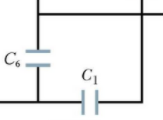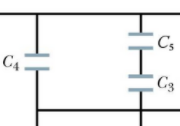Cs C4- C3 C6 (a) Capacitor C, is in neither v with capacitor C2. (b) Capacitor C, is in series | with capacitor Cg. (c) Capacitor C, is in -select- v with capacitor Cg.
Dielectric Constant Of Water
Water constitutes about 70% of earth. Some important distinguishing properties of water are high molar concentration, small dissociation constant and high dielectric constant.
Electrostatic Potential and Capacitance
An electrostatic force is a force caused by stationary electric charges /fields. The electrostatic force is caused by the transfer of electrons in conducting materials. Coulomb’s law determines the amount of force between two stationary, charged particles. The electric force is the force which acts between two stationary charges. It is also called Coulomb force.

Solution:
a) Capacitor C1 is in Series with capacitor C2
explanation: because C1 and C6 as combinedly in series with C4, C2, C3, C5, once we apply the series and parallel calculation across the circuit
b) Capacitor C4 is in Series with capacitor C6
explanation: clearly shown in the circuit that these are in series

c) Capacitor C1 is in Parallel with capacitor C6
explanation: clearly shown in the circuit that these are in parallel, we can see in the below image, we separate it from the circuit and analysis

d) Capacitor C3 is in Series with capacitor C5
explanation: we can see in the below image, we separate it from the circuit and analysis

e) Capacitor C4 is in Parallel with capacitor C5
explanation: we can see in the below image, we separate it from the circuit and analysis

f) Capacitor C4 has same voltage difference as Capacitor C2 as they are directly in parallel
e) capacitor C5 has same voltage difference as C3 (only in case all capacitor has same capacity)
h) it is True
Step by step
Solved in 2 steps with 4 images









